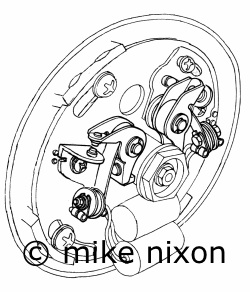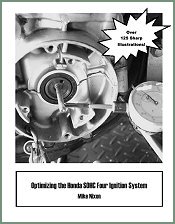|
2023 update: This article was written more than twenty years ago. In fact it was one of the articles I first built my website with in 1997. One thing that has changed during that time is the original equipment TEC and ND points are very hard to get now. Even the new ones Honda dealers sell under Honda part number today are junk. The original points are out there, they just have to be bought used or from CMSNL.
 Replacing the standard points plate with an electronically triggered setup is a common Honda SOHC Four upgrade. I am convinced that the process of servicing and timing the stock ignition is just too daunting for most. It's too bad. There is nothing wrong with the stock setup. It works very well. Replacing the standard points plate with an electronically triggered setup is a common Honda SOHC Four upgrade. I am convinced that the process of servicing and timing the stock ignition is just too daunting for most. It's too bad. There is nothing wrong with the stock setup. It works very well.
Point gap
People get all worked up about point gap, as if it were integral to actual timing. It is important, but not that important. If your gaps vary by 0.003" that is fine. There is a reason Honda gave a range, after all. Careful techs discovered long ago that setting the point gap to the minimum end of its range increases the performance of the Kettering system. The time the points are closed ("dwell") is increased, and coil saturation time and output voltage are maximized.
Dwell
Point dwell is just a way to measure gap with the engine running. Technically of course it's the opposite of gap, but don't worry about that. The two are inextricably tied together. Dwell is preferred over gap because as a running measurement, dwell is an easier way to get the two points nearly the same. Folks also get in a sweat about the dwell specification. Due to very few dwell meters being made for motorcycles, the dwell process can be confusing. It is as follows. First, carefully set the gaps using a feeler gauge. Then set the meter's scale so you get needle response on the runnning machine, and take note of the scale reading. Simply set both points to that reading.
Looseness
The points backing plate is a very loose fit in the crankcase casting, which results in timing and dwell changes with each adjustment to the timing. To deal with that, use only a stock points backing plate. Its thick steel design resists the heat warpage that is common with the thinner steel and less rigid aluminum aftermarket plates. It also fits best, but you can make it fit even better by lightly peening the crankcase bosses all around the plate to snug it up (see the illustration at the top of this page). It should be so tight that it will rotate only with a forceful nudge.
Contact points
Honda used only two brands of points on the SOHC Fours: TEC (Toyo Electrical Company) and ND (Nippon Denso). These points are best because they're made the best: the pivots have the least slop, the steel bracket is the stoutest and flattest, and the contacts are the most resistant to burning. There are of course several aftermarket point assemblies available to fit the SOHC Four, among them Mitsubishi and Daiichi, but Honda never used these inferior products as original equipment on the Fours. Their poorly stamped, light gauge, rounded backs cause them to change timing when the screws are tightened, their springs are not as firm, and their insulating washers are flimsy. In a word, they're junk.
Strobelight timing
A strobelight is also essential, but for a different reason. This tool reveals the entire timing curve instead of just the timing at idle. The manual explains how to use it. The manual omits however any mention of the two most common problems with the SOHC Four's advance mechanism. First, very early CB750s have off-center advancer mounting studs. The hole in the crankshaft was drilled eccentric to the main journal, resulting in a wobbly point cam and subsequent ignition timing inaccuracy (specifically, "ghost effect"). The factory
recommended truing the stud during a tune episode. The other problem is common to all Honda mechanical advancers: they eventually over-advance. In a mechanical advance assembly, the advance limit is determined by flyweights which bang against stop ears built into the unit. The ears gradually bend outward with the miles, permitting the timing to over-advance slightly, which results in pinging and flattened full throttle acceleration. When strobe-timing your system, first make sure the bike is idling at no more than 1100 rpm. Next, ensure that the idle timing is at the "F" mark at that rpm (or less). Once these are correct, rev the engine until all the advance is in. The timing should advance no further than dead on the second of the twin full advance marks. If the system advances farther than this, and the idle timing is correct, the advancer is in need of tweaking. Remove it and gently squeeze its ears in a vise. Gently. You may want to use a caliper. We're talking maybe 0.020". Put it back in, re-dwell and re-time, and check the advance again. Don't lubricate the advancer mechanism. Its hardened steel design completely eliminates the need for lubrication that was the hallmark (and downfall) of its pushrod British twin counterpart. Do however lubricate the point cam, using either Harley-Davidson or Delco point cam grease. Your points will return the favor: the stock points will wear very slowly if kept clean, dressed and lubed. It is acceptable to dress them, and cared for a set can last up to 20,000 miles.
Don't buy an electronic ignition. Carefully set up, the stock points system can go head to head with the best of the points replacement systems.
Recommended Reading:
Powersports Ignition Evolution
Resistor Plugs, Wires, and Related Issues
U-Gap and Splitfire Spark Plugs
High Performance Ignition Coils
Honda DOHC, CBX Ignition System Troubleshooting
Reading Spark Plugs
GL1000 Ignition Tech
|

 ®
®

 Replacing the standard points plate with an electronically triggered setup is a common Honda SOHC Four upgrade. I am convinced that the process of servicing and timing the stock ignition is just too daunting for most. It's too bad. There is nothing wrong with the stock setup. It works very well.
Replacing the standard points plate with an electronically triggered setup is a common Honda SOHC Four upgrade. I am convinced that the process of servicing and timing the stock ignition is just too daunting for most. It's too bad. There is nothing wrong with the stock setup. It works very well.